Evaluation of Auditors' Role in BHP Billiton's Annual Report
VerifiedAdded on 2023/06/08
|12
|3429
|55
AI Summary
This report evaluates the role of auditors in BHP Billiton's annual report, including their independence, significant audit matters, and audit committee. It also discusses material subsequent events and the efficiency of material information disclosed by auditors. The report highlights the importance of auditors in forming an opinion on the financials of an organization and their role in corporate governance. The report concludes that material information is either missing or remains under-reported in the annual report of BHP Billiton.
Contribute Materials
Your contribution can guide someone’s learning journey. Share your
documents today.
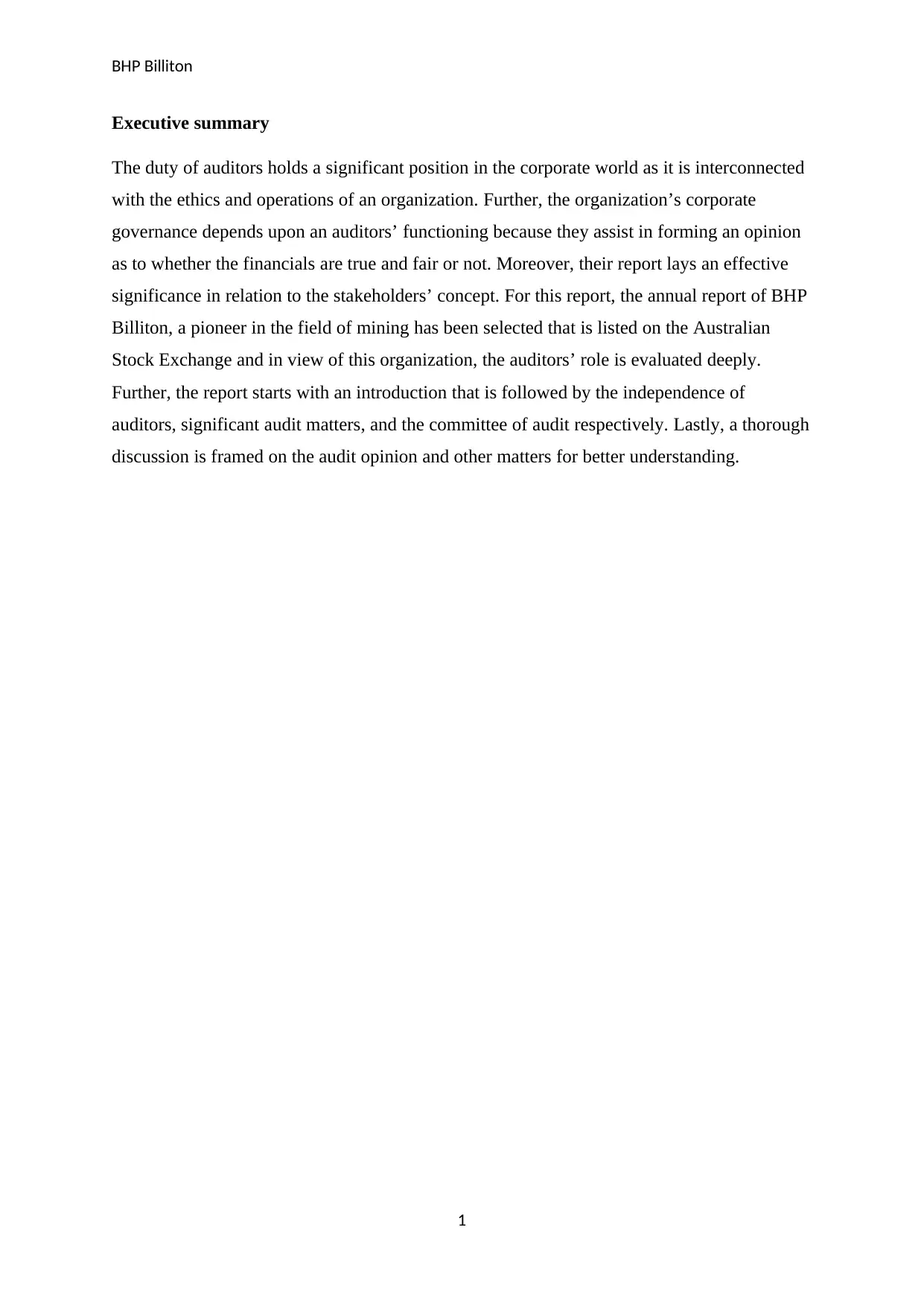
BHP Billiton
Executive summary
The duty of auditors holds a significant position in the corporate world as it is interconnected
with the ethics and operations of an organization. Further, the organization’s corporate
governance depends upon an auditors’ functioning because they assist in forming an opinion
as to whether the financials are true and fair or not. Moreover, their report lays an effective
significance in relation to the stakeholders’ concept. For this report, the annual report of BHP
Billiton, a pioneer in the field of mining has been selected that is listed on the Australian
Stock Exchange and in view of this organization, the auditors’ role is evaluated deeply.
Further, the report starts with an introduction that is followed by the independence of
auditors, significant audit matters, and the committee of audit respectively. Lastly, a thorough
discussion is framed on the audit opinion and other matters for better understanding.
1
Executive summary
The duty of auditors holds a significant position in the corporate world as it is interconnected
with the ethics and operations of an organization. Further, the organization’s corporate
governance depends upon an auditors’ functioning because they assist in forming an opinion
as to whether the financials are true and fair or not. Moreover, their report lays an effective
significance in relation to the stakeholders’ concept. For this report, the annual report of BHP
Billiton, a pioneer in the field of mining has been selected that is listed on the Australian
Stock Exchange and in view of this organization, the auditors’ role is evaluated deeply.
Further, the report starts with an introduction that is followed by the independence of
auditors, significant audit matters, and the committee of audit respectively. Lastly, a thorough
discussion is framed on the audit opinion and other matters for better understanding.
1
Secure Best Marks with AI Grader
Need help grading? Try our AI Grader for instant feedback on your assignments.
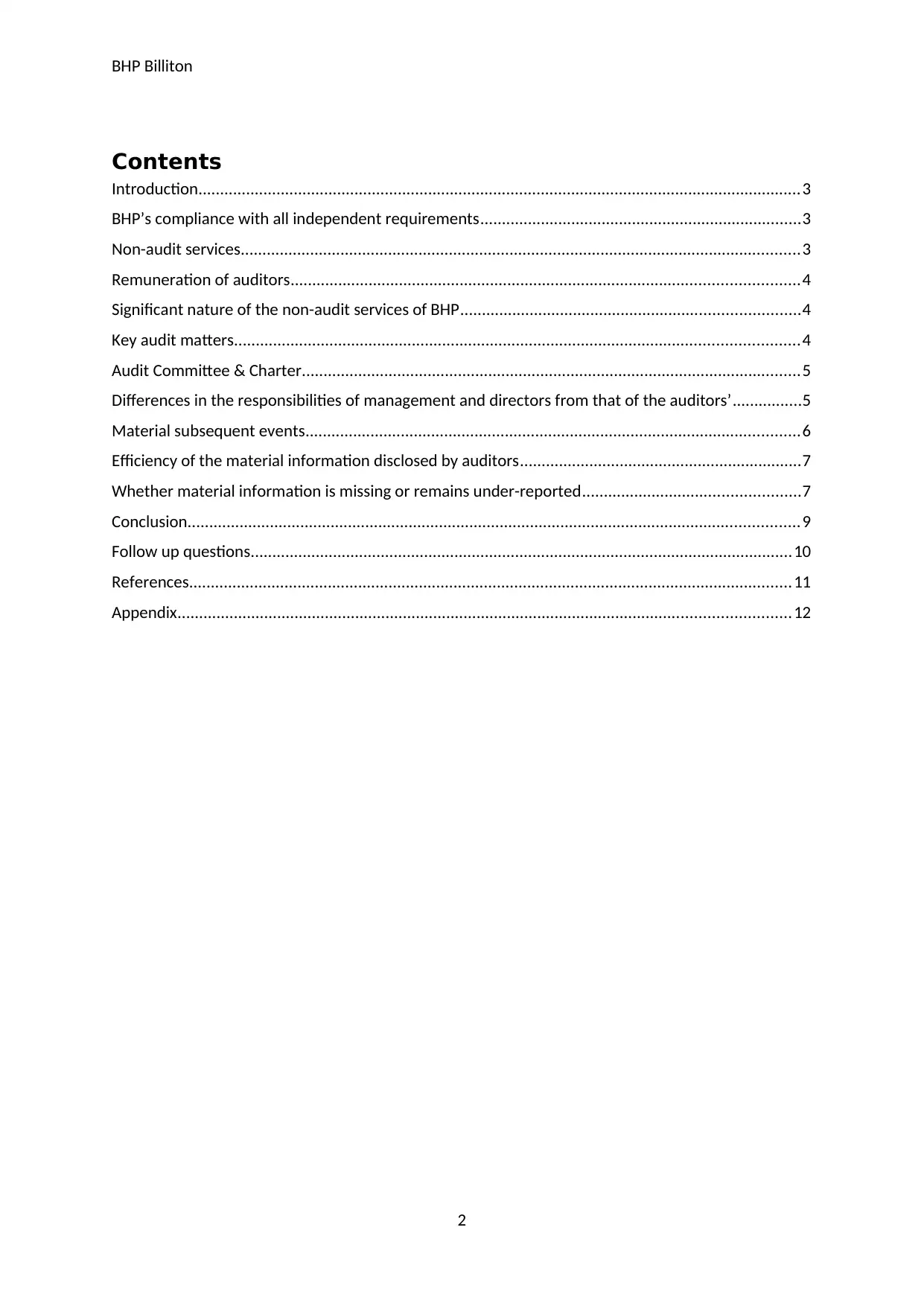
BHP Billiton
Contents
Introduction...........................................................................................................................................3
BHP’s compliance with all independent requirements..........................................................................3
Non-audit services.................................................................................................................................3
Remuneration of auditors.....................................................................................................................4
Significant nature of the non-audit services of BHP..............................................................................4
Key audit matters..................................................................................................................................4
Audit Committee & Charter...................................................................................................................5
Differences in the responsibilities of management and directors from that of the auditors’................5
Material subsequent events..................................................................................................................6
Efficiency of the material information disclosed by auditors.................................................................7
Whether material information is missing or remains under-reported..................................................7
Conclusion.............................................................................................................................................9
Follow up questions.............................................................................................................................10
References...........................................................................................................................................11
Appendix.............................................................................................................................................12
2
Contents
Introduction...........................................................................................................................................3
BHP’s compliance with all independent requirements..........................................................................3
Non-audit services.................................................................................................................................3
Remuneration of auditors.....................................................................................................................4
Significant nature of the non-audit services of BHP..............................................................................4
Key audit matters..................................................................................................................................4
Audit Committee & Charter...................................................................................................................5
Differences in the responsibilities of management and directors from that of the auditors’................5
Material subsequent events..................................................................................................................6
Efficiency of the material information disclosed by auditors.................................................................7
Whether material information is missing or remains under-reported..................................................7
Conclusion.............................................................................................................................................9
Follow up questions.............................................................................................................................10
References...........................................................................................................................................11
Appendix.............................................................................................................................................12
2
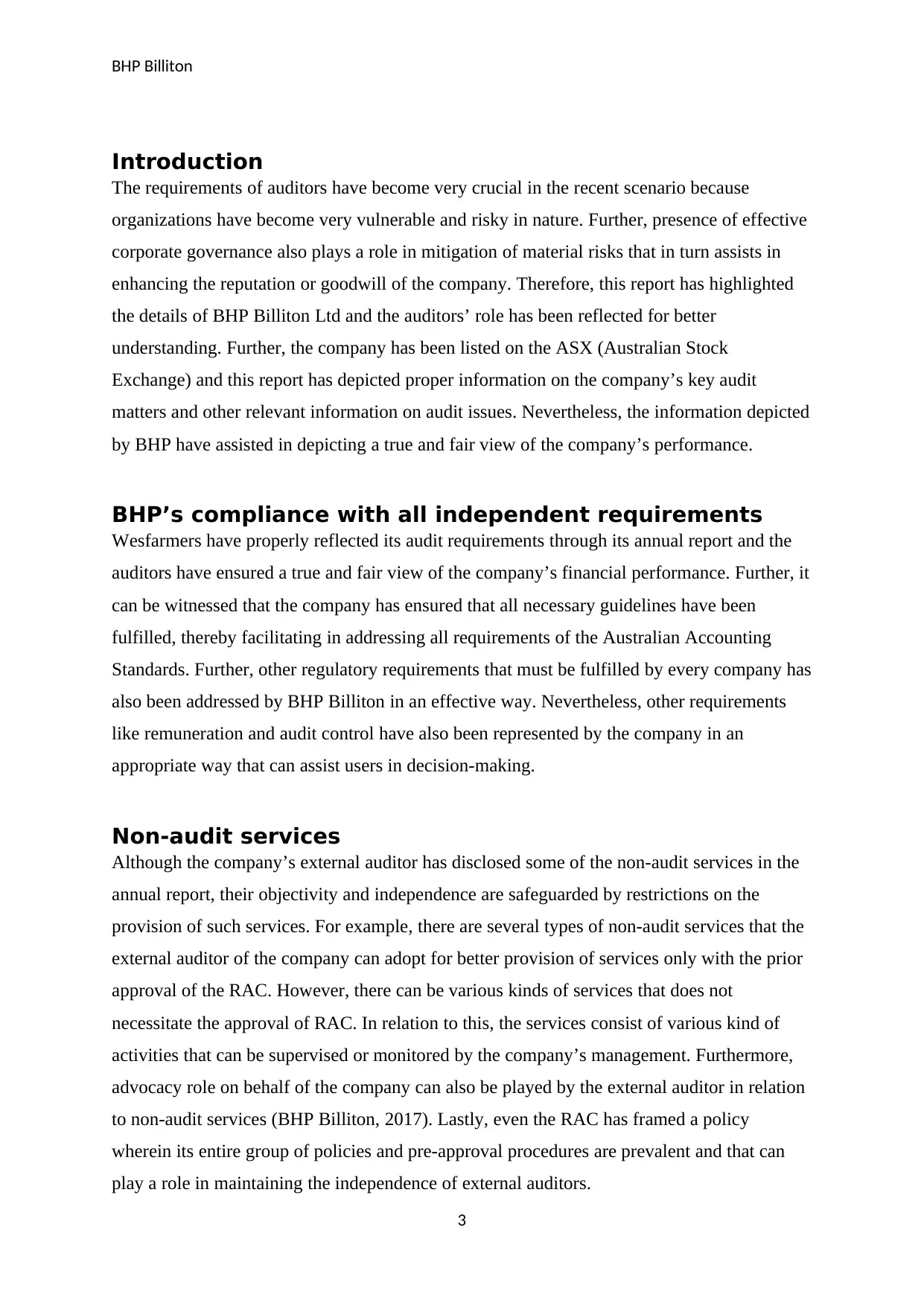
BHP Billiton
Introduction
The requirements of auditors have become very crucial in the recent scenario because
organizations have become very vulnerable and risky in nature. Further, presence of effective
corporate governance also plays a role in mitigation of material risks that in turn assists in
enhancing the reputation or goodwill of the company. Therefore, this report has highlighted
the details of BHP Billiton Ltd and the auditors’ role has been reflected for better
understanding. Further, the company has been listed on the ASX (Australian Stock
Exchange) and this report has depicted proper information on the company’s key audit
matters and other relevant information on audit issues. Nevertheless, the information depicted
by BHP have assisted in depicting a true and fair view of the company’s performance.
BHP’s compliance with all independent requirements
Wesfarmers have properly reflected its audit requirements through its annual report and the
auditors have ensured a true and fair view of the company’s financial performance. Further, it
can be witnessed that the company has ensured that all necessary guidelines have been
fulfilled, thereby facilitating in addressing all requirements of the Australian Accounting
Standards. Further, other regulatory requirements that must be fulfilled by every company has
also been addressed by BHP Billiton in an effective way. Nevertheless, other requirements
like remuneration and audit control have also been represented by the company in an
appropriate way that can assist users in decision-making.
Non-audit services
Although the company’s external auditor has disclosed some of the non-audit services in the
annual report, their objectivity and independence are safeguarded by restrictions on the
provision of such services. For example, there are several types of non-audit services that the
external auditor of the company can adopt for better provision of services only with the prior
approval of the RAC. However, there can be various kinds of services that does not
necessitate the approval of RAC. In relation to this, the services consist of various kind of
activities that can be supervised or monitored by the company’s management. Furthermore,
advocacy role on behalf of the company can also be played by the external auditor in relation
to non-audit services (BHP Billiton, 2017). Lastly, even the RAC has framed a policy
wherein its entire group of policies and pre-approval procedures are prevalent and that can
play a role in maintaining the independence of external auditors.
3
Introduction
The requirements of auditors have become very crucial in the recent scenario because
organizations have become very vulnerable and risky in nature. Further, presence of effective
corporate governance also plays a role in mitigation of material risks that in turn assists in
enhancing the reputation or goodwill of the company. Therefore, this report has highlighted
the details of BHP Billiton Ltd and the auditors’ role has been reflected for better
understanding. Further, the company has been listed on the ASX (Australian Stock
Exchange) and this report has depicted proper information on the company’s key audit
matters and other relevant information on audit issues. Nevertheless, the information depicted
by BHP have assisted in depicting a true and fair view of the company’s performance.
BHP’s compliance with all independent requirements
Wesfarmers have properly reflected its audit requirements through its annual report and the
auditors have ensured a true and fair view of the company’s financial performance. Further, it
can be witnessed that the company has ensured that all necessary guidelines have been
fulfilled, thereby facilitating in addressing all requirements of the Australian Accounting
Standards. Further, other regulatory requirements that must be fulfilled by every company has
also been addressed by BHP Billiton in an effective way. Nevertheless, other requirements
like remuneration and audit control have also been represented by the company in an
appropriate way that can assist users in decision-making.
Non-audit services
Although the company’s external auditor has disclosed some of the non-audit services in the
annual report, their objectivity and independence are safeguarded by restrictions on the
provision of such services. For example, there are several types of non-audit services that the
external auditor of the company can adopt for better provision of services only with the prior
approval of the RAC. However, there can be various kinds of services that does not
necessitate the approval of RAC. In relation to this, the services consist of various kind of
activities that can be supervised or monitored by the company’s management. Furthermore,
advocacy role on behalf of the company can also be played by the external auditor in relation
to non-audit services (BHP Billiton, 2017). Lastly, even the RAC has framed a policy
wherein its entire group of policies and pre-approval procedures are prevalent and that can
play a role in maintaining the independence of external auditors.
3
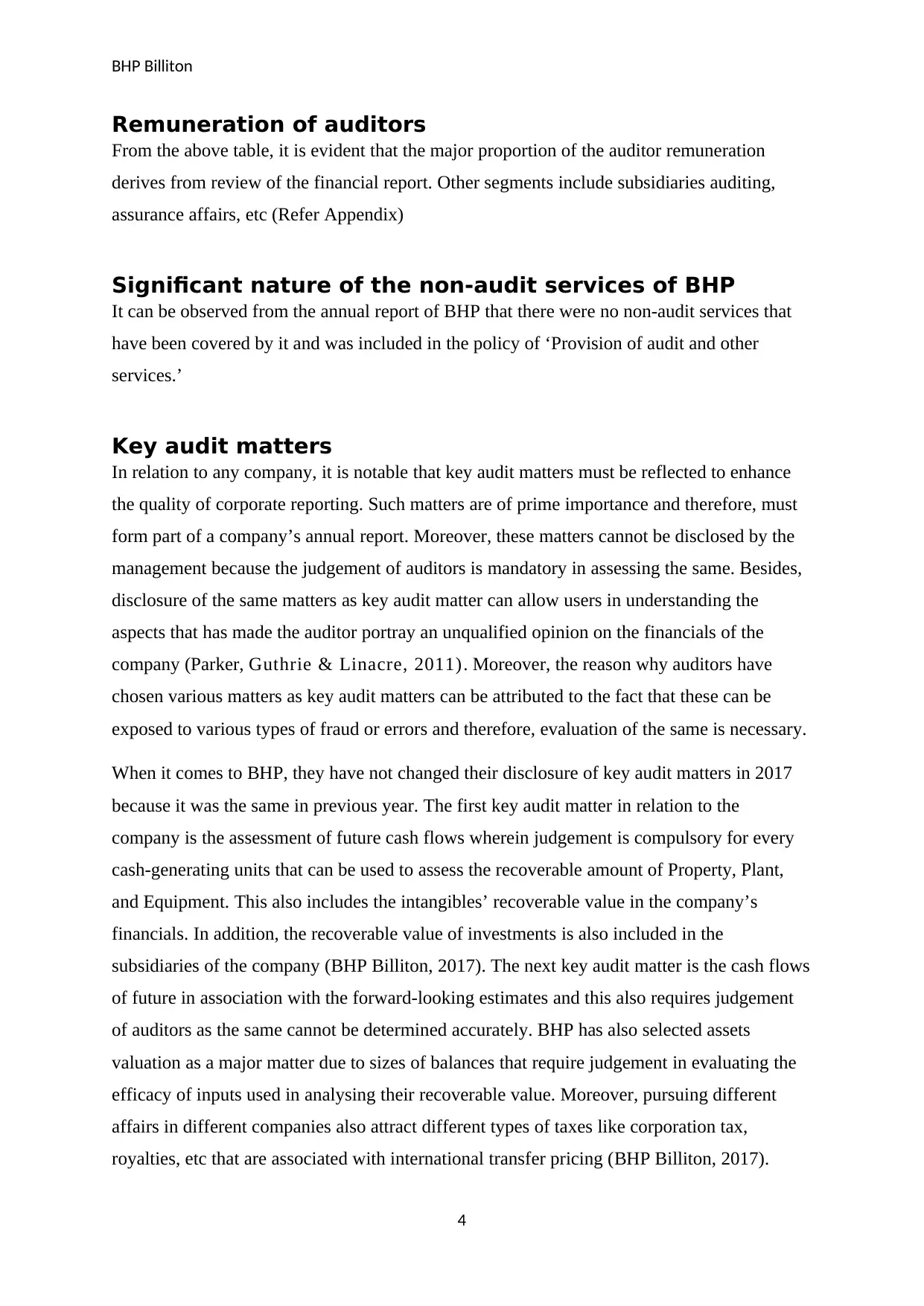
BHP Billiton
Remuneration of auditors
From the above table, it is evident that the major proportion of the auditor remuneration
derives from review of the financial report. Other segments include subsidiaries auditing,
assurance affairs, etc (Refer Appendix)
Significant nature of the non-audit services of BHP
It can be observed from the annual report of BHP that there were no non-audit services that
have been covered by it and was included in the policy of ‘Provision of audit and other
services.’
Key audit matters
In relation to any company, it is notable that key audit matters must be reflected to enhance
the quality of corporate reporting. Such matters are of prime importance and therefore, must
form part of a company’s annual report. Moreover, these matters cannot be disclosed by the
management because the judgement of auditors is mandatory in assessing the same. Besides,
disclosure of the same matters as key audit matter can allow users in understanding the
aspects that has made the auditor portray an unqualified opinion on the financials of the
company (Parker, Guthrie & Linacre, 2011). Moreover, the reason why auditors have
chosen various matters as key audit matters can be attributed to the fact that these can be
exposed to various types of fraud or errors and therefore, evaluation of the same is necessary.
When it comes to BHP, they have not changed their disclosure of key audit matters in 2017
because it was the same in previous year. The first key audit matter in relation to the
company is the assessment of future cash flows wherein judgement is compulsory for every
cash-generating units that can be used to assess the recoverable amount of Property, Plant,
and Equipment. This also includes the intangibles’ recoverable value in the company’s
financials. In addition, the recoverable value of investments is also included in the
subsidiaries of the company (BHP Billiton, 2017). The next key audit matter is the cash flows
of future in association with the forward-looking estimates and this also requires judgement
of auditors as the same cannot be determined accurately. BHP has also selected assets
valuation as a major matter due to sizes of balances that require judgement in evaluating the
efficacy of inputs used in analysing their recoverable value. Moreover, pursuing different
affairs in different companies also attract different types of taxes like corporation tax,
royalties, etc that are associated with international transfer pricing (BHP Billiton, 2017).
4
Remuneration of auditors
From the above table, it is evident that the major proportion of the auditor remuneration
derives from review of the financial report. Other segments include subsidiaries auditing,
assurance affairs, etc (Refer Appendix)
Significant nature of the non-audit services of BHP
It can be observed from the annual report of BHP that there were no non-audit services that
have been covered by it and was included in the policy of ‘Provision of audit and other
services.’
Key audit matters
In relation to any company, it is notable that key audit matters must be reflected to enhance
the quality of corporate reporting. Such matters are of prime importance and therefore, must
form part of a company’s annual report. Moreover, these matters cannot be disclosed by the
management because the judgement of auditors is mandatory in assessing the same. Besides,
disclosure of the same matters as key audit matter can allow users in understanding the
aspects that has made the auditor portray an unqualified opinion on the financials of the
company (Parker, Guthrie & Linacre, 2011). Moreover, the reason why auditors have
chosen various matters as key audit matters can be attributed to the fact that these can be
exposed to various types of fraud or errors and therefore, evaluation of the same is necessary.
When it comes to BHP, they have not changed their disclosure of key audit matters in 2017
because it was the same in previous year. The first key audit matter in relation to the
company is the assessment of future cash flows wherein judgement is compulsory for every
cash-generating units that can be used to assess the recoverable amount of Property, Plant,
and Equipment. This also includes the intangibles’ recoverable value in the company’s
financials. In addition, the recoverable value of investments is also included in the
subsidiaries of the company (BHP Billiton, 2017). The next key audit matter is the cash flows
of future in association with the forward-looking estimates and this also requires judgement
of auditors as the same cannot be determined accurately. BHP has also selected assets
valuation as a major matter due to sizes of balances that require judgement in evaluating the
efficacy of inputs used in analysing their recoverable value. Moreover, pursuing different
affairs in different companies also attract different types of taxes like corporation tax,
royalties, etc that are associated with international transfer pricing (BHP Billiton, 2017).
4
Secure Best Marks with AI Grader
Need help grading? Try our AI Grader for instant feedback on your assignments.
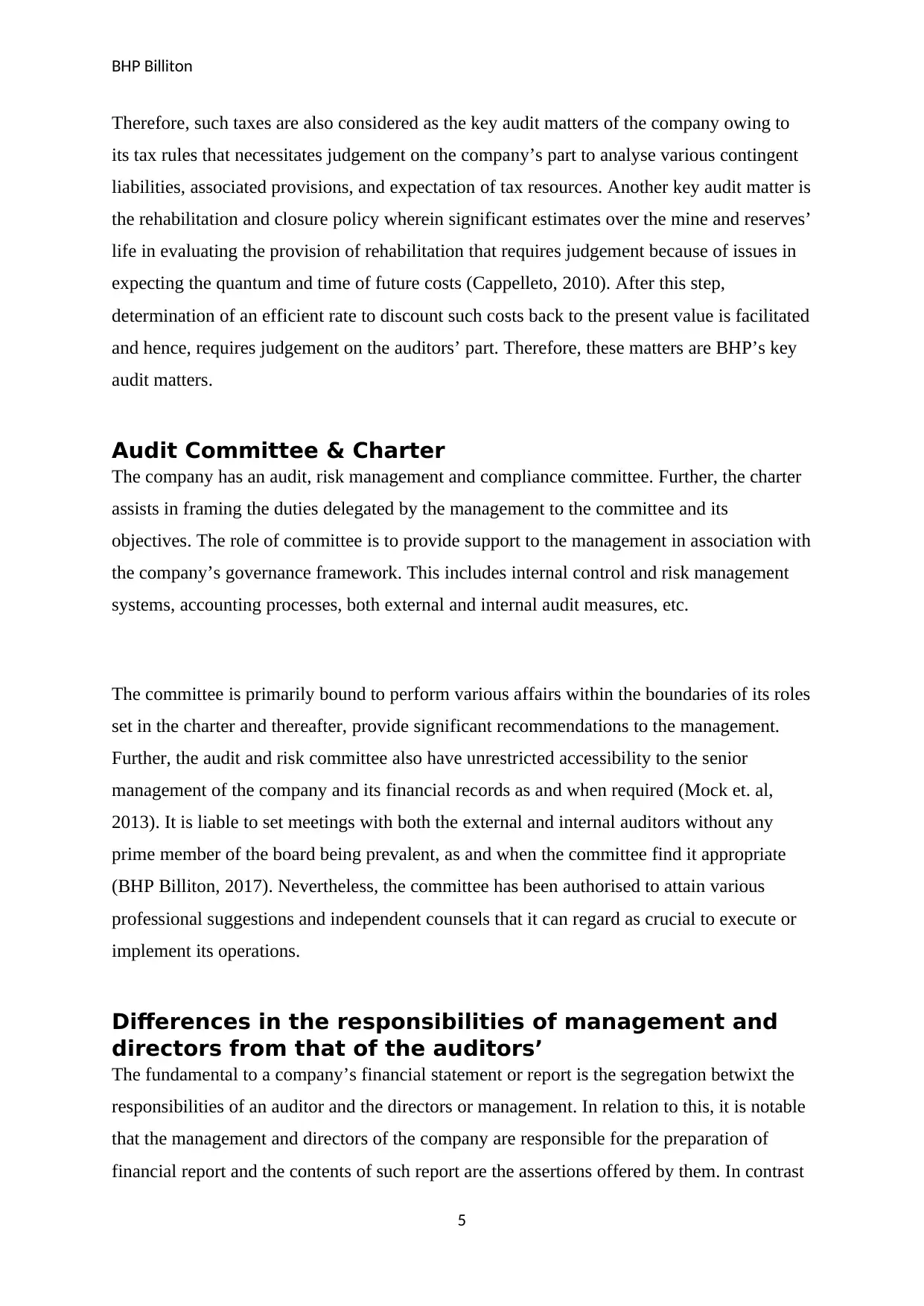
BHP Billiton
Therefore, such taxes are also considered as the key audit matters of the company owing to
its tax rules that necessitates judgement on the company’s part to analyse various contingent
liabilities, associated provisions, and expectation of tax resources. Another key audit matter is
the rehabilitation and closure policy wherein significant estimates over the mine and reserves’
life in evaluating the provision of rehabilitation that requires judgement because of issues in
expecting the quantum and time of future costs (Cappelleto, 2010). After this step,
determination of an efficient rate to discount such costs back to the present value is facilitated
and hence, requires judgement on the auditors’ part. Therefore, these matters are BHP’s key
audit matters.
Audit Committee & Charter
The company has an audit, risk management and compliance committee. Further, the charter
assists in framing the duties delegated by the management to the committee and its
objectives. The role of committee is to provide support to the management in association with
the company’s governance framework. This includes internal control and risk management
systems, accounting processes, both external and internal audit measures, etc.
The committee is primarily bound to perform various affairs within the boundaries of its roles
set in the charter and thereafter, provide significant recommendations to the management.
Further, the audit and risk committee also have unrestricted accessibility to the senior
management of the company and its financial records as and when required (Mock et. al,
2013). It is liable to set meetings with both the external and internal auditors without any
prime member of the board being prevalent, as and when the committee find it appropriate
(BHP Billiton, 2017). Nevertheless, the committee has been authorised to attain various
professional suggestions and independent counsels that it can regard as crucial to execute or
implement its operations.
Differences in the responsibilities of management and
directors from that of the auditors’
The fundamental to a company’s financial statement or report is the segregation betwixt the
responsibilities of an auditor and the directors or management. In relation to this, it is notable
that the management and directors of the company are responsible for the preparation of
financial report and the contents of such report are the assertions offered by them. In contrast
5
Therefore, such taxes are also considered as the key audit matters of the company owing to
its tax rules that necessitates judgement on the company’s part to analyse various contingent
liabilities, associated provisions, and expectation of tax resources. Another key audit matter is
the rehabilitation and closure policy wherein significant estimates over the mine and reserves’
life in evaluating the provision of rehabilitation that requires judgement because of issues in
expecting the quantum and time of future costs (Cappelleto, 2010). After this step,
determination of an efficient rate to discount such costs back to the present value is facilitated
and hence, requires judgement on the auditors’ part. Therefore, these matters are BHP’s key
audit matters.
Audit Committee & Charter
The company has an audit, risk management and compliance committee. Further, the charter
assists in framing the duties delegated by the management to the committee and its
objectives. The role of committee is to provide support to the management in association with
the company’s governance framework. This includes internal control and risk management
systems, accounting processes, both external and internal audit measures, etc.
The committee is primarily bound to perform various affairs within the boundaries of its roles
set in the charter and thereafter, provide significant recommendations to the management.
Further, the audit and risk committee also have unrestricted accessibility to the senior
management of the company and its financial records as and when required (Mock et. al,
2013). It is liable to set meetings with both the external and internal auditors without any
prime member of the board being prevalent, as and when the committee find it appropriate
(BHP Billiton, 2017). Nevertheless, the committee has been authorised to attain various
professional suggestions and independent counsels that it can regard as crucial to execute or
implement its operations.
Differences in the responsibilities of management and
directors from that of the auditors’
The fundamental to a company’s financial statement or report is the segregation betwixt the
responsibilities of an auditor and the directors or management. In relation to this, it is notable
that the management and directors of the company are responsible for the preparation of
financial report and the contents of such report are the assertions offered by them. In contrast
5
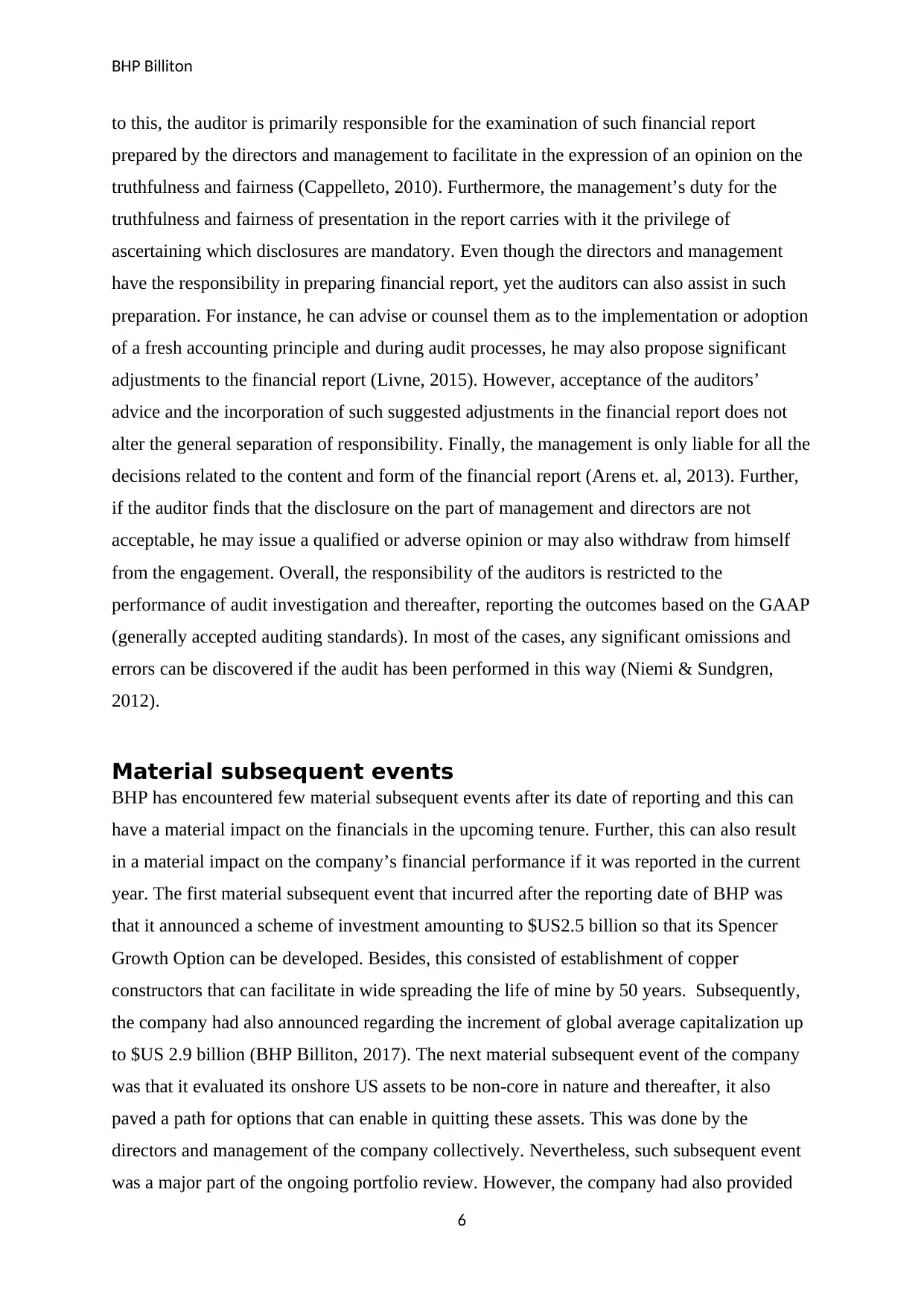
BHP Billiton
to this, the auditor is primarily responsible for the examination of such financial report
prepared by the directors and management to facilitate in the expression of an opinion on the
truthfulness and fairness (Cappelleto, 2010). Furthermore, the management’s duty for the
truthfulness and fairness of presentation in the report carries with it the privilege of
ascertaining which disclosures are mandatory. Even though the directors and management
have the responsibility in preparing financial report, yet the auditors can also assist in such
preparation. For instance, he can advise or counsel them as to the implementation or adoption
of a fresh accounting principle and during audit processes, he may also propose significant
adjustments to the financial report (Livne, 2015). However, acceptance of the auditors’
advice and the incorporation of such suggested adjustments in the financial report does not
alter the general separation of responsibility. Finally, the management is only liable for all the
decisions related to the content and form of the financial report (Arens et. al, 2013). Further,
if the auditor finds that the disclosure on the part of management and directors are not
acceptable, he may issue a qualified or adverse opinion or may also withdraw from himself
from the engagement. Overall, the responsibility of the auditors is restricted to the
performance of audit investigation and thereafter, reporting the outcomes based on the GAAP
(generally accepted auditing standards). In most of the cases, any significant omissions and
errors can be discovered if the audit has been performed in this way (Niemi & Sundgren,
2012).
Material subsequent events
BHP has encountered few material subsequent events after its date of reporting and this can
have a material impact on the financials in the upcoming tenure. Further, this can also result
in a material impact on the company’s financial performance if it was reported in the current
year. The first material subsequent event that incurred after the reporting date of BHP was
that it announced a scheme of investment amounting to $US2.5 billion so that its Spencer
Growth Option can be developed. Besides, this consisted of establishment of copper
constructors that can facilitate in wide spreading the life of mine by 50 years. Subsequently,
the company had also announced regarding the increment of global average capitalization up
to $US 2.9 billion (BHP Billiton, 2017). The next material subsequent event of the company
was that it evaluated its onshore US assets to be non-core in nature and thereafter, it also
paved a path for options that can enable in quitting these assets. This was done by the
directors and management of the company collectively. Nevertheless, such subsequent event
was a major part of the ongoing portfolio review. However, the company had also provided
6
to this, the auditor is primarily responsible for the examination of such financial report
prepared by the directors and management to facilitate in the expression of an opinion on the
truthfulness and fairness (Cappelleto, 2010). Furthermore, the management’s duty for the
truthfulness and fairness of presentation in the report carries with it the privilege of
ascertaining which disclosures are mandatory. Even though the directors and management
have the responsibility in preparing financial report, yet the auditors can also assist in such
preparation. For instance, he can advise or counsel them as to the implementation or adoption
of a fresh accounting principle and during audit processes, he may also propose significant
adjustments to the financial report (Livne, 2015). However, acceptance of the auditors’
advice and the incorporation of such suggested adjustments in the financial report does not
alter the general separation of responsibility. Finally, the management is only liable for all the
decisions related to the content and form of the financial report (Arens et. al, 2013). Further,
if the auditor finds that the disclosure on the part of management and directors are not
acceptable, he may issue a qualified or adverse opinion or may also withdraw from himself
from the engagement. Overall, the responsibility of the auditors is restricted to the
performance of audit investigation and thereafter, reporting the outcomes based on the GAAP
(generally accepted auditing standards). In most of the cases, any significant omissions and
errors can be discovered if the audit has been performed in this way (Niemi & Sundgren,
2012).
Material subsequent events
BHP has encountered few material subsequent events after its date of reporting and this can
have a material impact on the financials in the upcoming tenure. Further, this can also result
in a material impact on the company’s financial performance if it was reported in the current
year. The first material subsequent event that incurred after the reporting date of BHP was
that it announced a scheme of investment amounting to $US2.5 billion so that its Spencer
Growth Option can be developed. Besides, this consisted of establishment of copper
constructors that can facilitate in wide spreading the life of mine by 50 years. Subsequently,
the company had also announced regarding the increment of global average capitalization up
to $US 2.9 billion (BHP Billiton, 2017). The next material subsequent event of the company
was that it evaluated its onshore US assets to be non-core in nature and thereafter, it also
paved a path for options that can enable in quitting these assets. This was done by the
directors and management of the company collectively. Nevertheless, such subsequent event
was a major part of the ongoing portfolio review. However, the company had also provided
6
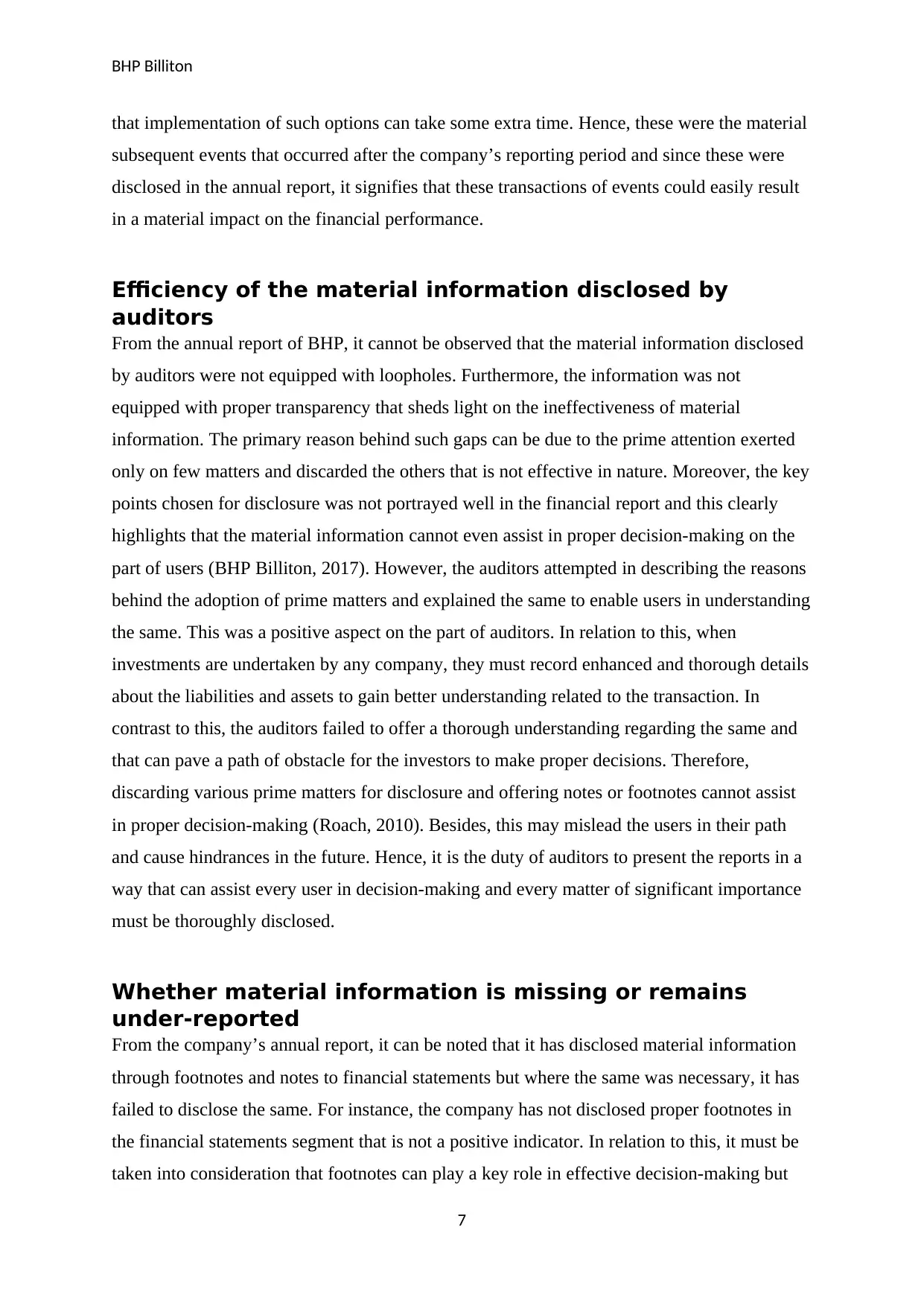
BHP Billiton
that implementation of such options can take some extra time. Hence, these were the material
subsequent events that occurred after the company’s reporting period and since these were
disclosed in the annual report, it signifies that these transactions of events could easily result
in a material impact on the financial performance.
Efficiency of the material information disclosed by
auditors
From the annual report of BHP, it cannot be observed that the material information disclosed
by auditors were not equipped with loopholes. Furthermore, the information was not
equipped with proper transparency that sheds light on the ineffectiveness of material
information. The primary reason behind such gaps can be due to the prime attention exerted
only on few matters and discarded the others that is not effective in nature. Moreover, the key
points chosen for disclosure was not portrayed well in the financial report and this clearly
highlights that the material information cannot even assist in proper decision-making on the
part of users (BHP Billiton, 2017). However, the auditors attempted in describing the reasons
behind the adoption of prime matters and explained the same to enable users in understanding
the same. This was a positive aspect on the part of auditors. In relation to this, when
investments are undertaken by any company, they must record enhanced and thorough details
about the liabilities and assets to gain better understanding related to the transaction. In
contrast to this, the auditors failed to offer a thorough understanding regarding the same and
that can pave a path of obstacle for the investors to make proper decisions. Therefore,
discarding various prime matters for disclosure and offering notes or footnotes cannot assist
in proper decision-making (Roach, 2010). Besides, this may mislead the users in their path
and cause hindrances in the future. Hence, it is the duty of auditors to present the reports in a
way that can assist every user in decision-making and every matter of significant importance
must be thoroughly disclosed.
Whether material information is missing or remains
under-reported
From the company’s annual report, it can be noted that it has disclosed material information
through footnotes and notes to financial statements but where the same was necessary, it has
failed to disclose the same. For instance, the company has not disclosed proper footnotes in
the financial statements segment that is not a positive indicator. In relation to this, it must be
taken into consideration that footnotes can play a key role in effective decision-making but
7
that implementation of such options can take some extra time. Hence, these were the material
subsequent events that occurred after the company’s reporting period and since these were
disclosed in the annual report, it signifies that these transactions of events could easily result
in a material impact on the financial performance.
Efficiency of the material information disclosed by
auditors
From the annual report of BHP, it cannot be observed that the material information disclosed
by auditors were not equipped with loopholes. Furthermore, the information was not
equipped with proper transparency that sheds light on the ineffectiveness of material
information. The primary reason behind such gaps can be due to the prime attention exerted
only on few matters and discarded the others that is not effective in nature. Moreover, the key
points chosen for disclosure was not portrayed well in the financial report and this clearly
highlights that the material information cannot even assist in proper decision-making on the
part of users (BHP Billiton, 2017). However, the auditors attempted in describing the reasons
behind the adoption of prime matters and explained the same to enable users in understanding
the same. This was a positive aspect on the part of auditors. In relation to this, when
investments are undertaken by any company, they must record enhanced and thorough details
about the liabilities and assets to gain better understanding related to the transaction. In
contrast to this, the auditors failed to offer a thorough understanding regarding the same and
that can pave a path of obstacle for the investors to make proper decisions. Therefore,
discarding various prime matters for disclosure and offering notes or footnotes cannot assist
in proper decision-making (Roach, 2010). Besides, this may mislead the users in their path
and cause hindrances in the future. Hence, it is the duty of auditors to present the reports in a
way that can assist every user in decision-making and every matter of significant importance
must be thoroughly disclosed.
Whether material information is missing or remains
under-reported
From the company’s annual report, it can be noted that it has disclosed material information
through footnotes and notes to financial statements but where the same was necessary, it has
failed to disclose the same. For instance, the company has not disclosed proper footnotes in
the financial statements segment that is not a positive indicator. In relation to this, it must be
taken into consideration that footnotes can play a key role in effective decision-making but
7
Paraphrase This Document
Need a fresh take? Get an instant paraphrase of this document with our AI Paraphraser
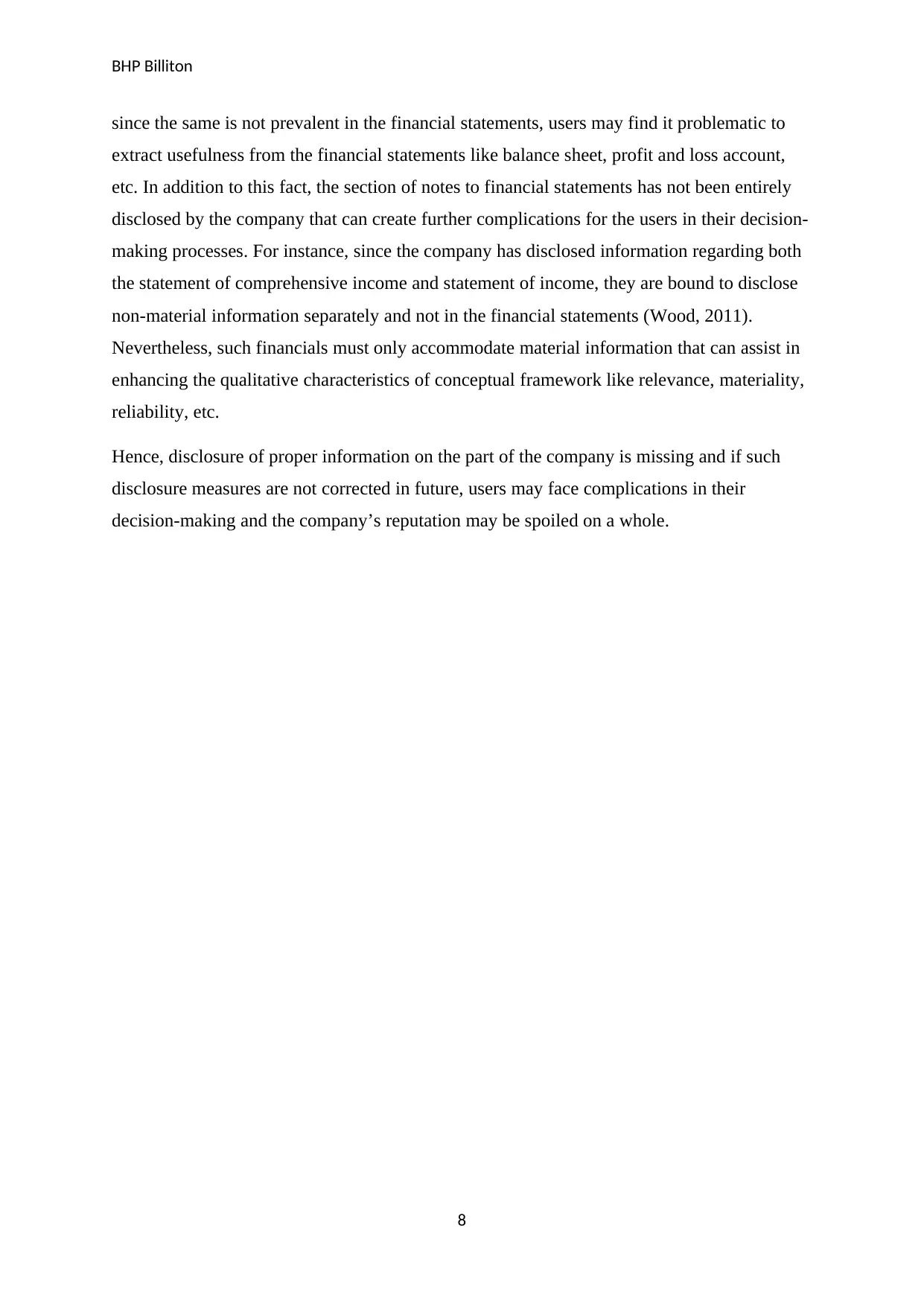
BHP Billiton
since the same is not prevalent in the financial statements, users may find it problematic to
extract usefulness from the financial statements like balance sheet, profit and loss account,
etc. In addition to this fact, the section of notes to financial statements has not been entirely
disclosed by the company that can create further complications for the users in their decision-
making processes. For instance, since the company has disclosed information regarding both
the statement of comprehensive income and statement of income, they are bound to disclose
non-material information separately and not in the financial statements (Wood, 2011).
Nevertheless, such financials must only accommodate material information that can assist in
enhancing the qualitative characteristics of conceptual framework like relevance, materiality,
reliability, etc.
Hence, disclosure of proper information on the part of the company is missing and if such
disclosure measures are not corrected in future, users may face complications in their
decision-making and the company’s reputation may be spoiled on a whole.
8
since the same is not prevalent in the financial statements, users may find it problematic to
extract usefulness from the financial statements like balance sheet, profit and loss account,
etc. In addition to this fact, the section of notes to financial statements has not been entirely
disclosed by the company that can create further complications for the users in their decision-
making processes. For instance, since the company has disclosed information regarding both
the statement of comprehensive income and statement of income, they are bound to disclose
non-material information separately and not in the financial statements (Wood, 2011).
Nevertheless, such financials must only accommodate material information that can assist in
enhancing the qualitative characteristics of conceptual framework like relevance, materiality,
reliability, etc.
Hence, disclosure of proper information on the part of the company is missing and if such
disclosure measures are not corrected in future, users may face complications in their
decision-making and the company’s reputation may be spoiled on a whole.
8
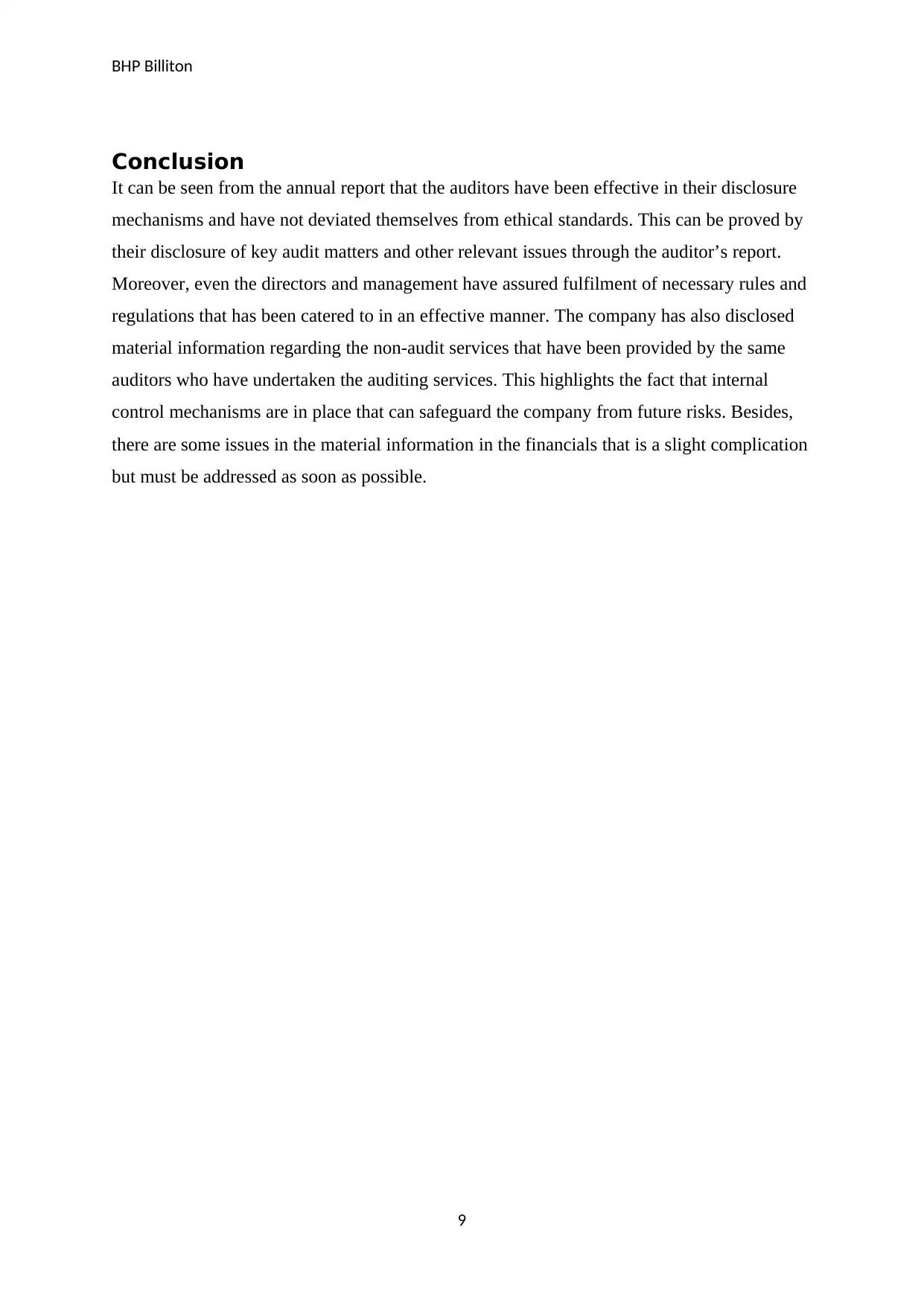
BHP Billiton
Conclusion
It can be seen from the annual report that the auditors have been effective in their disclosure
mechanisms and have not deviated themselves from ethical standards. This can be proved by
their disclosure of key audit matters and other relevant issues through the auditor’s report.
Moreover, even the directors and management have assured fulfilment of necessary rules and
regulations that has been catered to in an effective manner. The company has also disclosed
material information regarding the non-audit services that have been provided by the same
auditors who have undertaken the auditing services. This highlights the fact that internal
control mechanisms are in place that can safeguard the company from future risks. Besides,
there are some issues in the material information in the financials that is a slight complication
but must be addressed as soon as possible.
9
Conclusion
It can be seen from the annual report that the auditors have been effective in their disclosure
mechanisms and have not deviated themselves from ethical standards. This can be proved by
their disclosure of key audit matters and other relevant issues through the auditor’s report.
Moreover, even the directors and management have assured fulfilment of necessary rules and
regulations that has been catered to in an effective manner. The company has also disclosed
material information regarding the non-audit services that have been provided by the same
auditors who have undertaken the auditing services. This highlights the fact that internal
control mechanisms are in place that can safeguard the company from future risks. Besides,
there are some issues in the material information in the financials that is a slight complication
but must be addressed as soon as possible.
9
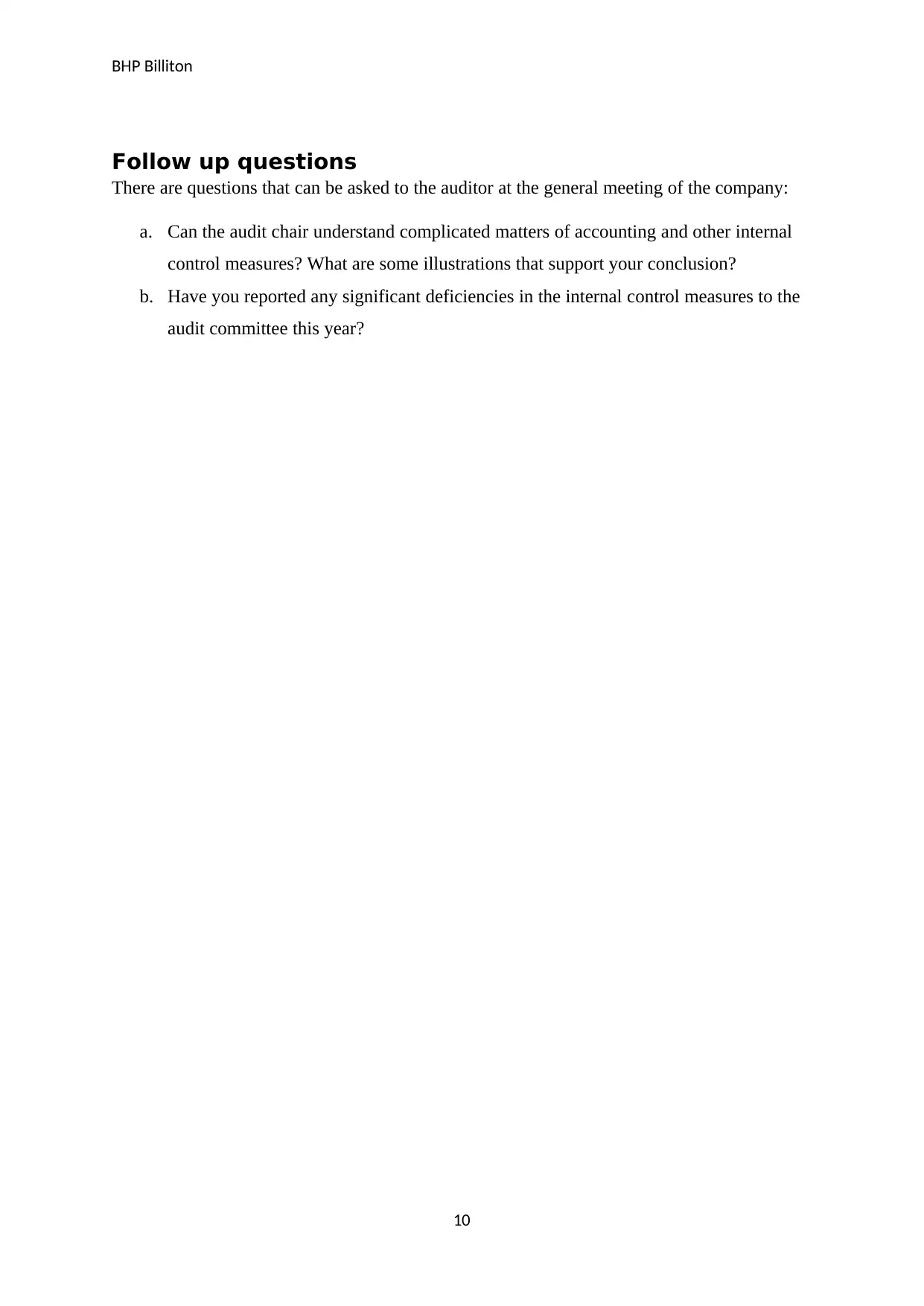
BHP Billiton
Follow up questions
There are questions that can be asked to the auditor at the general meeting of the company:
a. Can the audit chair understand complicated matters of accounting and other internal
control measures? What are some illustrations that support your conclusion?
b. Have you reported any significant deficiencies in the internal control measures to the
audit committee this year?
10
Follow up questions
There are questions that can be asked to the auditor at the general meeting of the company:
a. Can the audit chair understand complicated matters of accounting and other internal
control measures? What are some illustrations that support your conclusion?
b. Have you reported any significant deficiencies in the internal control measures to the
audit committee this year?
10
Secure Best Marks with AI Grader
Need help grading? Try our AI Grader for instant feedback on your assignments.
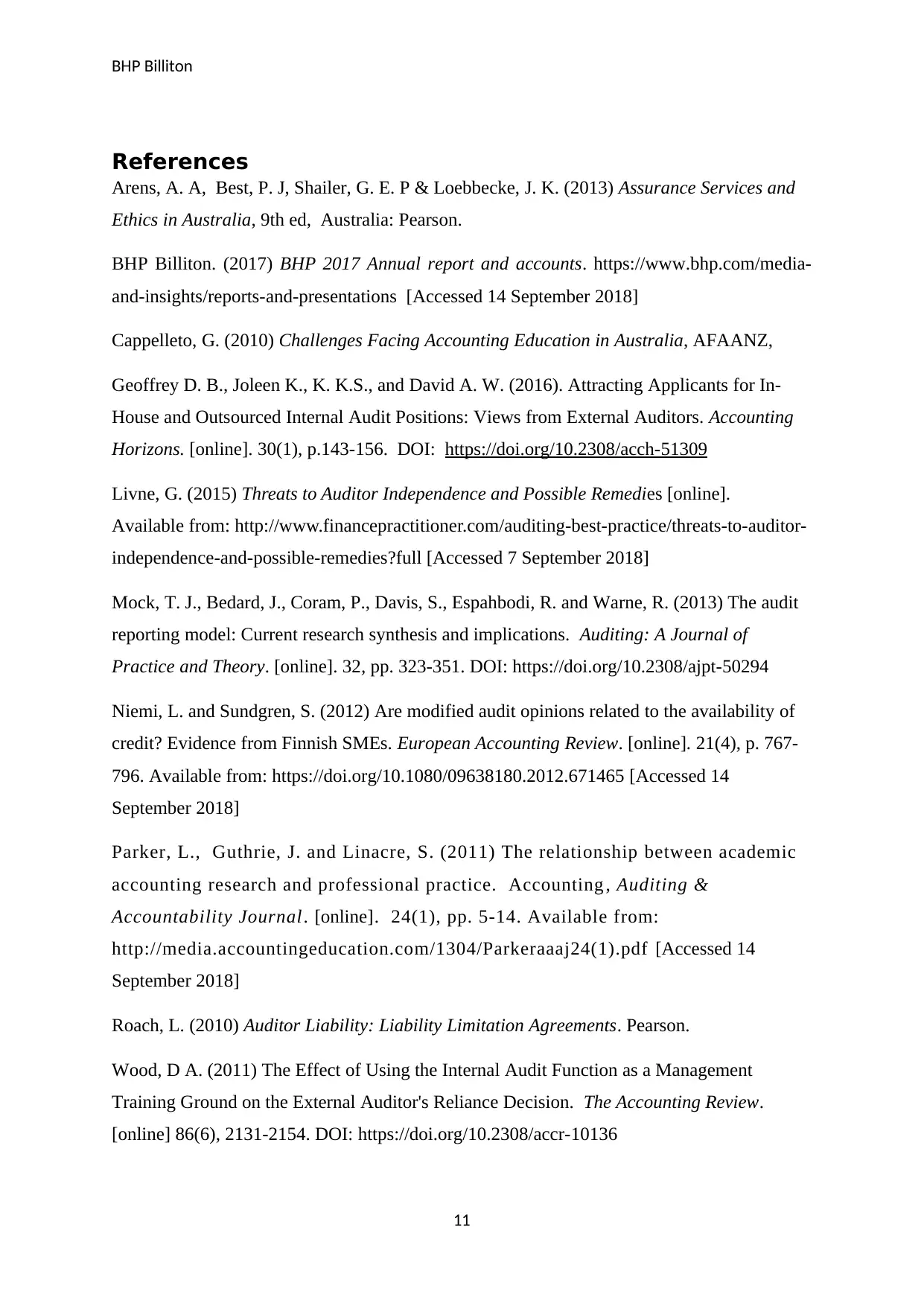
BHP Billiton
References
Arens, A. A, Best, P. J, Shailer, G. E. P & Loebbecke, J. K. (2013) Assurance Services and
Ethics in Australia, 9th ed, Australia: Pearson.
BHP Billiton. (2017) BHP 2017 Annual report and accounts. https://www.bhp.com/media-
and-insights/reports-and-presentations [Accessed 14 September 2018]
Cappelleto, G. (2010) Challenges Facing Accounting Education in Australia, AFAANZ,
Geoffrey D. B., Joleen K., K. K.S., and David A. W. (2016). Attracting Applicants for In-
House and Outsourced Internal Audit Positions: Views from External Auditors. Accounting
Horizons. [online]. 30(1), p.143-156. DOI: https://doi.org/10.2308/acch-51309
Livne, G. (2015) Threats to Auditor Independence and Possible Remedies [online].
Available from: http://www.financepractitioner.com/auditing-best-practice/threats-to-auditor-
independence-and-possible-remedies?full [Accessed 7 September 2018]
Mock, T. J., Bedard, J., Coram, P., Davis, S., Espahbodi, R. and Warne, R. (2013) The audit
reporting model: Current research synthesis and implications. Auditing: A Journal of
Practice and Theory. [online]. 32, pp. 323-351. DOI: https://doi.org/10.2308/ajpt-50294
Niemi, L. and Sundgren, S. (2012) Are modified audit opinions related to the availability of
credit? Evidence from Finnish SMEs. European Accounting Review. [online]. 21(4), p. 767-
796. Available from: https://doi.org/10.1080/09638180.2012.671465 [Accessed 14
September 2018]
Parker, L., Guthrie, J. and Linacre, S. (2011) The relationship between academic
accounting research and professional practice. Accounting , Auditing &
Accountability Journal. [online]. 24(1), pp. 5-14. Available from:
http://media.accountingeducation.com/1304/Parkeraaaj24(1).pdf [Accessed 14
September 2018]
Roach, L. (2010) Auditor Liability: Liability Limitation Agreements. Pearson.
Wood, D A. (2011) The Effect of Using the Internal Audit Function as a Management
Training Ground on the External Auditor's Reliance Decision. The Accounting Review.
[online] 86(6), 2131-2154. DOI: https://doi.org/10.2308/accr-10136
11
References
Arens, A. A, Best, P. J, Shailer, G. E. P & Loebbecke, J. K. (2013) Assurance Services and
Ethics in Australia, 9th ed, Australia: Pearson.
BHP Billiton. (2017) BHP 2017 Annual report and accounts. https://www.bhp.com/media-
and-insights/reports-and-presentations [Accessed 14 September 2018]
Cappelleto, G. (2010) Challenges Facing Accounting Education in Australia, AFAANZ,
Geoffrey D. B., Joleen K., K. K.S., and David A. W. (2016). Attracting Applicants for In-
House and Outsourced Internal Audit Positions: Views from External Auditors. Accounting
Horizons. [online]. 30(1), p.143-156. DOI: https://doi.org/10.2308/acch-51309
Livne, G. (2015) Threats to Auditor Independence and Possible Remedies [online].
Available from: http://www.financepractitioner.com/auditing-best-practice/threats-to-auditor-
independence-and-possible-remedies?full [Accessed 7 September 2018]
Mock, T. J., Bedard, J., Coram, P., Davis, S., Espahbodi, R. and Warne, R. (2013) The audit
reporting model: Current research synthesis and implications. Auditing: A Journal of
Practice and Theory. [online]. 32, pp. 323-351. DOI: https://doi.org/10.2308/ajpt-50294
Niemi, L. and Sundgren, S. (2012) Are modified audit opinions related to the availability of
credit? Evidence from Finnish SMEs. European Accounting Review. [online]. 21(4), p. 767-
796. Available from: https://doi.org/10.1080/09638180.2012.671465 [Accessed 14
September 2018]
Parker, L., Guthrie, J. and Linacre, S. (2011) The relationship between academic
accounting research and professional practice. Accounting , Auditing &
Accountability Journal. [online]. 24(1), pp. 5-14. Available from:
http://media.accountingeducation.com/1304/Parkeraaaj24(1).pdf [Accessed 14
September 2018]
Roach, L. (2010) Auditor Liability: Liability Limitation Agreements. Pearson.
Wood, D A. (2011) The Effect of Using the Internal Audit Function as a Management
Training Ground on the External Auditor's Reliance Decision. The Accounting Review.
[online] 86(6), 2131-2154. DOI: https://doi.org/10.2308/accr-10136
11
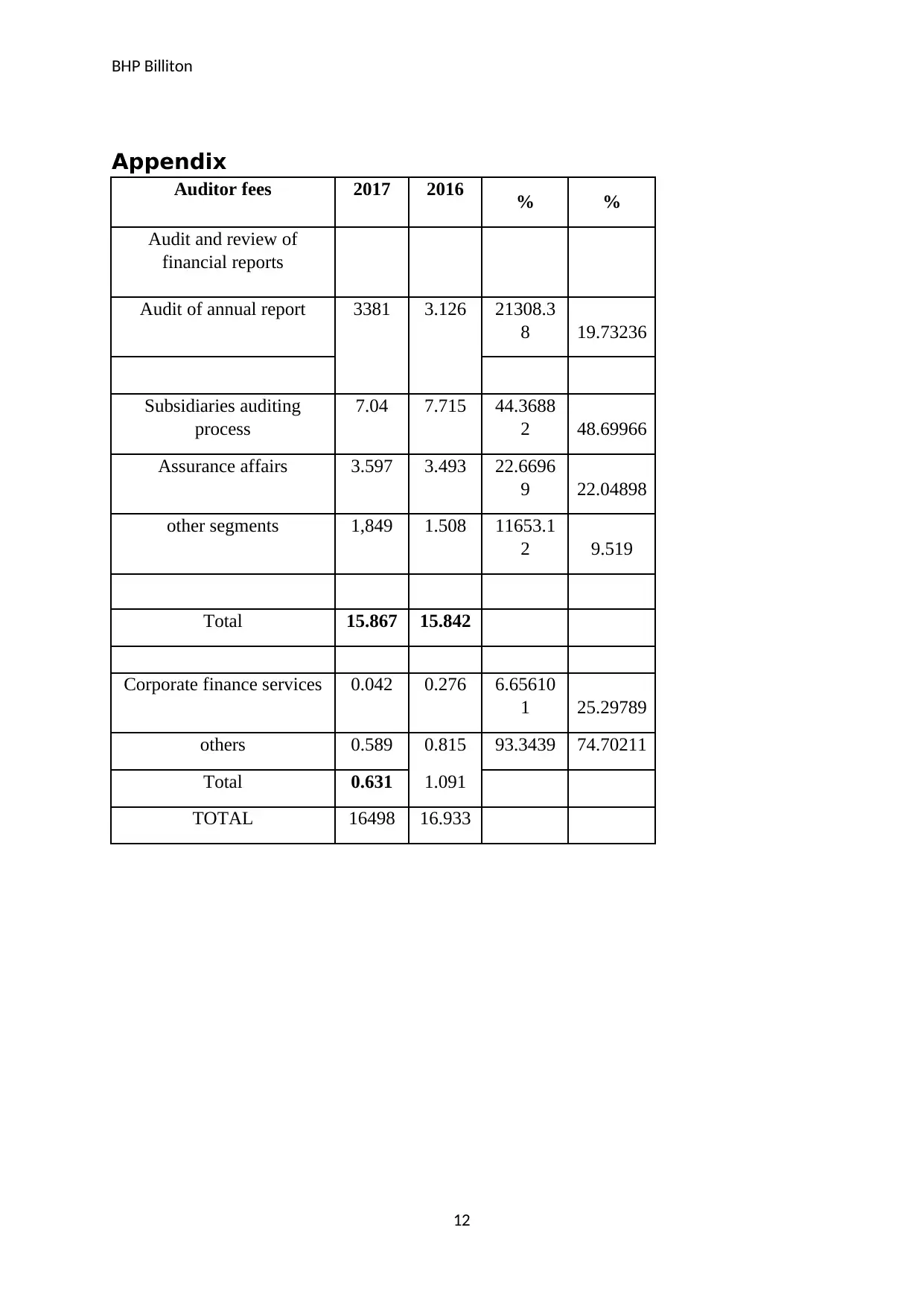
BHP Billiton
Appendix
Auditor fees 2017 2016 % %
Audit and review of
financial reports
Audit of annual report 3381 3.126 21308.3
8 19.73236
Subsidiaries auditing
process
7.04 7.715 44.3688
2 48.69966
Assurance affairs 3.597 3.493 22.6696
9 22.04898
other segments 1,849 1.508 11653.1
2 9.519
Total 15.867 15.842
Corporate finance services 0.042 0.276 6.65610
1 25.29789
others 0.589 0.815 93.3439 74.70211
Total 0.631 1.091
TOTAL 16498 16.933
12
Appendix
Auditor fees 2017 2016 % %
Audit and review of
financial reports
Audit of annual report 3381 3.126 21308.3
8 19.73236
Subsidiaries auditing
process
7.04 7.715 44.3688
2 48.69966
Assurance affairs 3.597 3.493 22.6696
9 22.04898
other segments 1,849 1.508 11653.1
2 9.519
Total 15.867 15.842
Corporate finance services 0.042 0.276 6.65610
1 25.29789
others 0.589 0.815 93.3439 74.70211
Total 0.631 1.091
TOTAL 16498 16.933
12
1 out of 12
Related Documents
Your All-in-One AI-Powered Toolkit for Academic Success.
+13062052269
info@desklib.com
Available 24*7 on WhatsApp / Email
![[object Object]](/_next/static/media/star-bottom.7253800d.svg)
Unlock your academic potential
© 2024 | Zucol Services PVT LTD | All rights reserved.




